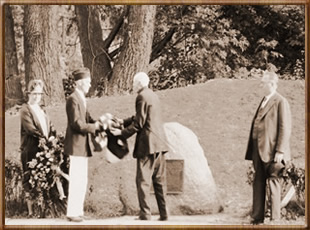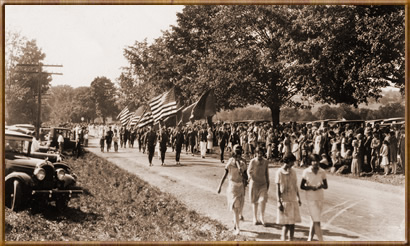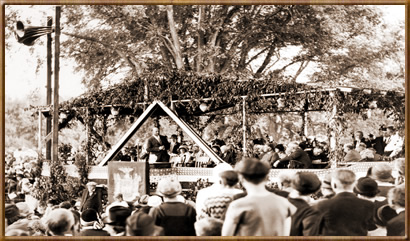| |
|
BOYD
AND PARKER PARK
IN CUYLERVILLE
|
This
pocket-sized park has an immense history
Over
the Genesee River in the hamlet of Cuylerville, in the town
of Leicester, a small park has been witness to some of the
most spectacular events in Livingston County. After the
remains of Thomas Boyd and Michael Parker were removed during
the elaborate 1841 Memorial Ceremony, the area remained
under private ownership until 1927 when the Livingston County
Historical Society obtained title to the property, "Rescuing
from oblivion the celebrated Torture Tree and the burial
mound of Scouts Boyd and Parker near Cuylerville in preparation
for the sesquicentennial of the Sullivan Expedition in 1929,"
was a primary objective of the society.(1)
The goal became a realty when the land was donated to the
Society by the Honorable James W. Gerard, the former Ambassador
to Germany.(2)
|

A
bronze tablet was unveiled in September, 1927 in
memory of Boyd and Parker by Mr. William Boyd (center),
a relative of Thomas Boyd.
|
|
The timing of
the acquisition was fortuitous. The University of the State
of New York had allocated sizable resources and appointed
a committee to organize events across the state to commemorate
the 150th anniversary of the American Revolution. Funds were
provided to place a boulder and bronze tablet at the burial
mound of Boyd and Parker. On September 17, 1927 the monument
to honor the soldiers was dedicated and a lavish historical
parade coincided with the unveiling ceremony. Yet another
local record was set this time the memorial event drew upwards
of 20,000 spectators with the automobile as the preferred
mode of transportation.
|
 A parade
of historic proportions, a mile and a half in length, took
almost an hour to wind its way through Cuylerville. Dozens
of floats, bands and organizations from all over Livingston
County and Rochester participated.
A parade
of historic proportions, a mile and a half in length, took
almost an hour to wind its way through Cuylerville. Dozens
of floats, bands and organizations from all over Livingston
County and Rochester participated.
|
 Speakers
included Dr. Arthur C. Parker and the Hon. James W. Wadsworth,
Jr. (pictured above).
Speakers
included Dr. Arthur C. Parker and the Hon. James W. Wadsworth,
Jr. (pictured above).
Photos
from the Livingston County Historian's collection.
|
|
The
year 1929 was perhaps one of the busiest years in the history
of Leicester as preparations for the 150th anniversary of
the Sullivan Campaign dominated the lives of most residents.
In addition to a massive historical pageant.(3)
a relatively quiet ceremony occurred the morning of September
14th. Another memorial was permanently installed and dedicated
by the Livingston County Historical Society. After an extensive
search, a ten ton granite boulder from a farm in Perry, New
York was selected as a suitable monument. The logistics of
pulling the enormous rock out of a tributary proved to be
quite a challenge. After breaking several heavy chains and
then transporting it more than seven miles, the boulder finally
came to rest at Boyd and Parker Park.
|
|
|
The park was
also enlarged that same year when Mr. Richard Wheelock, an
avid collector of Indian artifacts and one of the oldest residents
of Cuylerville, donated a small tract of land adjoining the
property. In gratitude he was made a life member of the society;
unfortunately however, Wheelock passed away the following
spring. After the Historical Society made substantial improvements,
the park (along with Ambuscade Park) was deeded to the New
York State Park Commission in 1930 to maintain as a historic
site. By the early 1970s the State closed the park due to
severe cuts in appropriations sparking community residents
to circulate petitions demanding the shrine be reopened. Fortunately
the town of Leicester was able to secure title to this hallowed
spot. When the 200th anniversary ceremonies took place in
1979 the crowds were smaller but strong patriotic fervor was
still readily apparent.(4)
|
The
Legend of the Torture Tree
The
centerpiece of Boyd and Parker Park is an ancient bur oak,
standing over 70 feet high and 24 feet in circumference and
estimated to be at least 250 years. Known far and wide as
the Torture Tree, local folklore comprised of nightmarish
and grotesque tales involving the deaths of Thomas Boyd and
Michael Parker have surrounded this tree for more than two
centuries. A popular account perpetuated since the early 19th
century tells of the captured soldiers bound to the tree,
tied with their own intestines while they were brutally tortured
and then "burned at the stake." No primary sources
of the time period have collaborated this particular version
of the story,(5)
however journals kept by Sullivan's officers did describe
the discovery of the beheaded and mutilated bodies as horrific.
|
|
|
The noble giant
is now a revered local landmark and as garnered recognition
for historic significance from outside of the area. During
a bicentennial observance in 1976 the age of the tree was
officially substantiated by the International Society of Arboriculture
and the National Arborist Association. In 1990 the Torture
Tree was honored again as being among only eleven trees in
the state placed on the New York State Registry of Trees.
Despite all
odds, the Torture Tree has continued to flourish, providing
the community with an enduring vision and a strong connection
to Livingston County's cultural heritage.
1-Lockwood
R. Doty, ed., "Report of the President," Boyd and
Parker, Heroes of the American Revolution. (Livingston County
Historical Society, 1928, 11.
2-See "Sullivan Campaign of the Revolutionary War: The
Impact on Livingston County," page 63 of for biographical
sketch of James W. Gerard.
3-See "Sullivan Campaign of the Revolutionary War: The
Impact on Livingston County," pages 67-67 for more on
the 150th Anniversary event.
4-See "Sullivan Campaign of the Revolutionary War: The
Impact on Livingston County," pages 71-74 for more on
the 200th Anniversary event.
5-The most likely origin of the story is contained in "The
Narrative of the Life of Mary Jemison" by James E. Seaver,
originally published in 1824.
|
| |
| (Sullivan
Campaign of the Revolutionary War: The Impact on Livingston
County, pages 59-61) Dr. William Blackwell |
|
|

